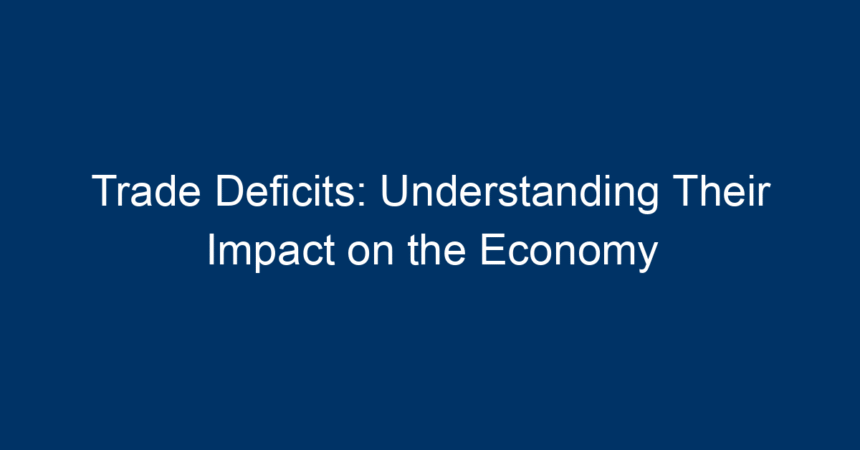In today’s globalized world, trade plays a crucial role in shaping economies. The term trade deficit frequently appears in economic discussions, sparking debates about its implications. But what exactly is a trade deficit, and how does it impact the economy? This article will explore the intricacies of trade deficits, their causes, effects, and how they shape the economic landscape in various countries.
What Is a Trade Deficit?
A trade deficit occurs when a country’s imports exceed its exports over a specific period. In simpler terms, it means that a nation is buying more goods and services from other countries than it is selling abroad. The formula is straightforward:
[
\text{Trade Balance} = \text{Exports} – \text{Imports}
]
When this balance yields a negative number, the result is a trade deficit. It’s important to differentiate between trade deficits and trade surpluses—the latter occurs when exports exceed imports.
Causes of Trade Deficits
Understanding the causes of trade deficits is essential for grasping their economic impact. The key drivers include:
1. Consumer Demand
Countries with high consumer demand often import more goods to satisfy their population’s needs. For instance, if a nation has a booming economy with a robust middle class, the demand for foreign goods will rise, leading to increased imports.
2. Strong Currency
When a country’s currency is strong, it can buy more foreign products, making imports cheaper. Conversely, a strong currency makes domestic products more expensive for foreign consumers, reducing exports.
3. Economic Growth
Rapid economic growth can lead to increased imports, as businesses and consumers seek goods and services to fuel expansion. While this may result in trade deficits, it can also indicate a thriving economy.
4. Global Supply Chains
The globalized economy has facilitated international supply chains, resulting in countries specializing in different production processes. Some nations may import raw materials while exporting finished goods, contributing to imbalances.
5. Trade Policies and Tariffs
Trade policies, including tariffs and quotas, can influence a nation’s trade balance. For instance, protective tariffs may reduce imports, thus affecting trade deficits and surpluses.
The Economic Impact of Trade Deficits
Trade deficits can have a variety of economic repercussions, both positive and negative.
Positive Effects
Economic Growth
Trade deficits can signal a growing economy. When consumers spend more on imports, it can boost overall economic activity. Businesses in importing countries may grow in response to increased consumer spending, contributing to job creation.
Access to Resources
Countries with trade deficits often benefit from access to resources or products not readily available domestically. This can foster innovation and improve the quality of life for citizens.
Foreign Investment
A trade deficit can attract foreign investments. Investors might see a country’s strong consumption patterns and potential for growth, leading to increased capital inflow.
Negative Effects
Currency Depreciation
A persistent trade deficit can lead to a depreciation of the national currency. When a country buys more abroad than it sells, demand for its currency may decrease, leading to higher import costs and inflation.
Job Losses
Industries that cannot compete with cheaper imported goods may suffer, resulting in job losses. This is particularly true in labor-intensive sectors where foreign competitors can offer lower prices.
Economic Vulnerabilities
Heavy reliance on imports can make a country vulnerable to global supply chain disruptions. Events such as natural disasters or geopolitical tensions may impact the availability of essential goods.
Trade Deficits and Inflation
The relationship between trade deficits and inflation is complex. While trade deficits can lead to currency depreciation, which may elevate import prices, the actual impact on inflation depends on various factors, including monetary policy and global economic conditions.
Short-Term vs. Long-Term Effects
Short-Term Effects: A sudden increase in imports due to high demand can lead to short-term inflation. However, through increased competition, prices may stabilize over time.
Long-Term Effects: Persistent trade deficits can lead to structural issues within the economy, potentially resulting in sustained inflation if the domestic currency weakens significantly.
Global Comparisons: How Trade Deficits Vary
Different countries experience trade deficits differently based on their economic structures and relationships with trading partners. Here are a couple of notable examples:
United States
The U.S. has long maintained a trade deficit, primarily due to its vast consumer market and reliance on foreign goods. This situation has led to debates about its impact on the American economy, with various policymakers advocating for different trade strategies.
China
China, on the other hand, has historically enjoyed trade surpluses, exporting more than it imports. This has allowed the country to amass foreign currency reserves, supporting its economic growth and global investment endeavors.
Debating Trade Deficits: Pros and Cons
The discussion around trade deficits often polarizes economists, politicians, and citizens alike. Let’s outline some key arguments from both sides.
Pro-Deficit Arguments
- Economic Growth Indicator: Some argue that trade deficits reflect a healthy economy, signaling consumer confidence and robust spending.
- Investment Opportunities: Trade deficits can attract foreign investments, as countries with strong demand are seen as fertile grounds for profits.
- Access to Cheaper Goods: Consumers benefit from lower prices on imported goods, enhancing their purchasing power.
Anti-Deficit Arguments
- Job Risks: Critics assert that trade deficits lead to domestic job losses, particularly in manufacturing sectors.
- Weakened Currency: Long-term deficits may erode the national currency’s value, causing inflation and economic instability.
- Dependence on Foreign Markets: Heavy reliance on imports can create vulnerabilities, particularly in times of crisis.
Conclusion: Navigating the Future of Trade Deficits
As global trade dynamics continue to evolve, understanding trade deficits will remain essential for businesses, policymakers, and consumers alike. A nuanced perspective acknowledging both the potential benefits and risks of trade deficits is crucial for informed decision-making.
Actionable Insights
-
For Consumers: Be aware of how trade deficits can affect the prices of goods and services you purchase. Understanding economic trends may empower you to make better financial choices.
-
For Investors: Monitor trade balances as indicators of economic health when making investment decisions. A growing trade deficit may not always signal a weakening economy, but context matters.
- For Policymakers: Consider balanced trade policies that support domestic industries while fostering beneficial international relationships.
In summary, trade deficits are multifaceted economic phenomena that can have significant implications for countries worldwide. By understanding these impacts, we can better navigate an increasingly interconnected world.




